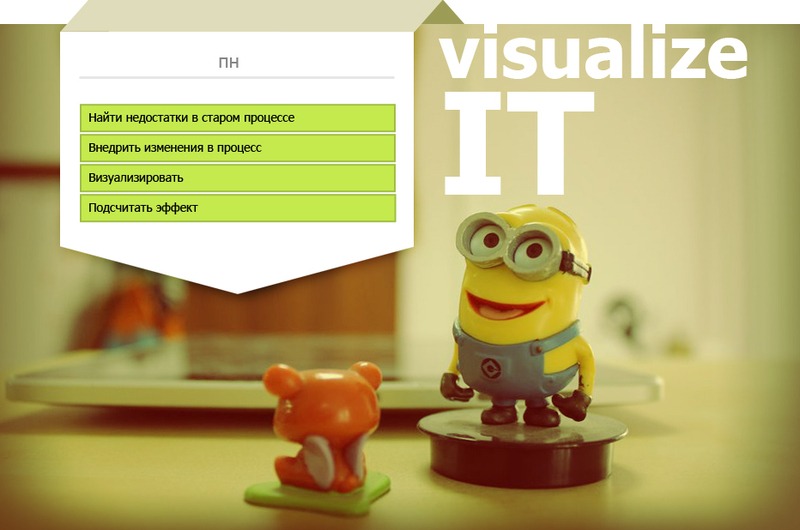Tool for planning and control from improvised materials

According to my observations, at the average IT conference, the number of reports about agiles and scrum has been slightly off-scale lately. At such a fit to play Agile Bullshit Bingo .
But no matter how you talk about good processes, there is always the opportunity to twist something and make it a little better. Today I’ll talk about how we struggled with the “forgetfulness” of project managers in our studio.
What was first
Planers with project managers (I will call them managers, for short) were held once a week. Every Monday we gathered at the big kanban board and looked at the cards. On each card was the name of the project, its lead manager and a list of tasks for the project planned for the past week. Tasks included project management and all the bureaucracy associated with it: contracts, acts, payments, negotiations, briefing, etc.
Then we analyzed: what was done, where difficulties arose and how to do better next time. They fixed it and then made a plan for the current week.
All “promises” were duplicated by the manager on Skype, after which he sat down for a weekly list of tasks and planned his project activities.
But it's not that simple
As it turned out, problems arise with this approach. It got to the point that about 40% of all planned tasks were not completed (or were not completed to the end, which is equivalent to "not completed").
We analyzed this
After the debriefing, we found out that we have two main reasons for failure.
The first is called "forgotten." Since a large project board was used only once a week, there was a chance that some “small” routine task was simply lost.
The second reason is "there were more important things to do." In the daily routine, no one even thought of setting priorities. Therefore, the manager, as a rule, decided for himself what needs to be done faster, and what can wait
And we started trying to change something
First of all, we rearranged the whole routine in Google Calendar.

It was almost good, but ...
We got the effect of “Waves of the horizon of planning”. I mean that the manager could not give an accurate forecast of all his routine work in advance (and he could not distribute the load either). Therefore, a “wave” was obtained: on Monday a huge number of tasks were planned, on Tuesday - fewer, on the remaining days - a void in the calendar.
Everything happened like this: on Monday, not all tasks were performed (which is natural), some of them “flowed” on Tuesday, then on Wednesday, and so on. And the tasks performed in fact, after such a wave - there were very, very few.
The calendar has helped to overcome “forgetfulness,” but that's not all. It remains to pack up the tasks by importance, plus to this - managers began to run out of breath. The belief that the “wave" can be defeated in general in a week has disappeared.
And we changed something again
Actually, the reason for demotivation is the constant "lack of reach" to their own plan. And ruthless pressure from the leadership, accompanied by shouts of “why not done ?!” and “until ?!”
Therefore, we decided to do this: put down the scheduled time for each task and physically limit their number per day. We found experimentally that the optimal total time for the day is six hours. The remaining two hours are unforeseen matters and “insurance” against inaccurate assessment.
The calendar also allowed not only to do tasks of varying degrees of duration, but also to assign each time a “start”.

Five minutes per person were allotted for such mini-planning. The manager and the head of the studio together looked at the plan for the day, conducted an express assessment of the time and chose the sequence of execution. Here we discussed the last day and, depending on the situation, distributed the remaining outstanding tasks.
Doctor, you did it!
In such a straightforward way, we almost completely got rid of the "wave". The feasibility has risen to the level of
And we did a simple visualization
We decided to do the obvious (but this solution was extremely effective).
We began to print daily plans. They gave each manager a bright text highlighter. As soon as the task was completed, it had to be crossed out with a marker.

Got three fat pluses
Firstly, it was enough to go through the office (30 seconds) to see the level of progress for everyone. The caustic colors of the highlighters are visible from afar.
Secondly, the managers themselves appeared quite tangible tool for self-motivation. The shaded plan is joy, the gaps in the plan are impending punishment. Simple and easy to understand. When the manager was loaded into
Thirdly, we got a rough, but a metric. Plan lists are now collected every morning and neatly stacked in containers with names.


We calculated the costs
For every
- Time:
5-10 minutes of the manager for self-planning of the day. 5-10 minutes manager and supervisor to analyze yesterday and develop a plan for the next day.- Total: from 60 to 120 minutes per week of working time.
- 5 sheets of paper per day.
- Printer toner, highlighter.
And - as a conclusion
There is no guarantee that this process will not be reviewed in a month or two, but so far I like what is happening. Plan-> Do-> Check-> Act without a break :)
